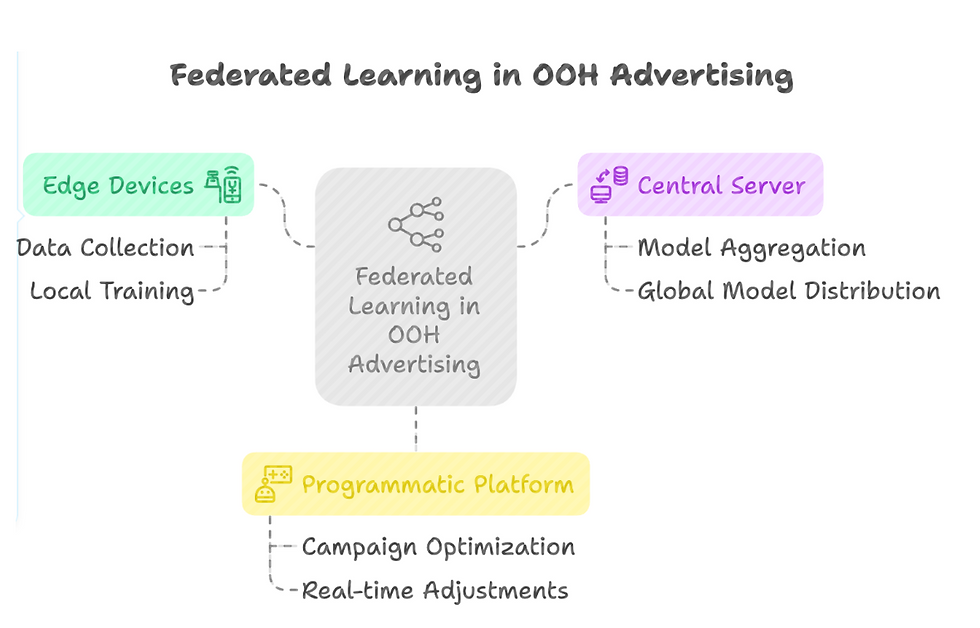Coupling Federated Learning and Programmatic OOH for robust Real-Time Data Analysis
- Vineet Singh
- Jul 9
- 3 min read
In this post, we’ll dive into how two cutting-edge technologies—Federated Learning (FL) and Programmatic Out-of-Home (OOH) advertising—can work together to transform real-time data analysis, all while keeping user privacy intact. We’ll explore the challenges this integration presents, the exciting opportunities it opens up, and some potential ways to make it happen.

What Are Federated Learning and Programmatic OOH?
Federated Learning is a smart machine learning approach that trains models directly on devices or servers where the data lives, instead of gathering all data in one place. This means sensitive information stays local, boosting privacy and security.
Programmatic OOH advertising uses data and automation to deliver targeted ads on digital billboards and other outdoor displays. It’s a dynamic way to reach audiences based on real-world conditions. By combining these two, advertisers can analyze data from many locations in real time, optimize campaigns on the fly, and respect user privacy—all at once.
Challenges to Overcome
Data Differences Across Locations: Every OOH spot has unique characteristics—different crowds, traffic flows, and environments. Federated Learning models need to handle this variety smoothly.
Limited Connectivity: Outdoor displays might not always have strong or stable internet, making it tricky to share updates between devices and central servers.
Privacy Risks: Even though FL is privacy-friendly, extra care is needed to avoid accidentally revealing sensitive info through the learning process.
Computing Power Limits: Many OOH devices have modest hardware, which can limit the complexity of models they can run locally.
Speed Requirements: Real-time campaign adjustments demand fast data processing and model updates, which can be challenging with limited resources.
Exciting Opportunities
Better Audience Targeting: FL lets advertisers combine insights from many locations without pooling raw data, leading to smarter, more effective ad targeting.
Real-Time Campaign Tweaks: Ads can adapt instantly to changes like traffic jams, weather shifts, or audience movement, maximizing impact.
Stronger Privacy Protections: Since raw data never leaves local devices, user privacy is safeguarded, helping brands stay compliant with regulations.
Local Insights You Can’t Get Elsewhere: FL can reveal hyperlocal trends and patterns that traditional methods might miss, giving advertisers a real edge.
More Accurate Campaign Measurement: By analyzing data from diverse sources—like mobile devices and traffic sensors—FL can help advertisers better understand how their campaigns perform.
By thoughtfully combining Federated Learning with Programmatic OOH advertising, we can unlock a future where outdoor ads are smarter, more responsive, and respectful of privacy. This synergy holds incredible promise for advertisers and audiences alike.

Potential Architectures
A potential architecture for coupling FL and programmatic OOH could involve the following components:
Edge Devices (OOH Displays): Each OOH display acts as an edge device, collecting data from sensors (e.g., cameras, traffic counters) and local data sources (e.g., demographic information).
Local Training: Each edge device trains a local FL model using its own data.
Central Server: A central server coordinates the FL process, aggregating model updates from the edge devices and distributing the updated global model.
Programmatic Platform: The programmatic platform uses the updated global model to optimize OOH campaigns in real-time.
Data Aggregation and Anonymization: Data collected at the edge is aggregated and anonymized before being used for local training.
Secure Communication: Secure communication channels are used to exchange model updates between the edge devices and the central server.

Use Cases
Dynamic Content Optimization: FL can be used to analyze real-time traffic patterns and weather conditions to dynamically adjust the content displayed on OOH displays. For example, during rush hour, the displays could show ads for coffee or energy drinks.
Audience Targeting: FL can be used to analyze audience demographics and interests to target OOH ads to specific groups of people. For example, near a sports stadium, the displays could show ads for sports apparel or tickets.
Campaign Measurement: FL can be used to measure the effectiveness of OOH campaigns by analyzing data from multiple sources, such as mobile devices and traffic sensors. This data can be used to optimize future campaigns.
Personalized Recommendations: While respecting privacy, FL can be used to provide personalized recommendations to people based on their location and interests. For example, near a restaurant, the displays could show ads for nearby restaurants with positive reviews.
Emergency Alerts: In emergency situations, FL can be used to quickly disseminate information to the public through OOH displays.
Conclusion
Coupling Federated Learning and Programmatic OOH advertising offers a powerful way to leverage real-time data analysis for improved targeting, optimization, and measurement of OOH campaigns, while preserving user privacy. While there are challenges to overcome, the potential benefits are significant. By carefully considering the architecture, algorithms, and security measures, advertisers can unlock the full potential of this innovative approach. Further research and development are needed to address the challenges and fully realize the potential of this integration.
